INTRODUCTION
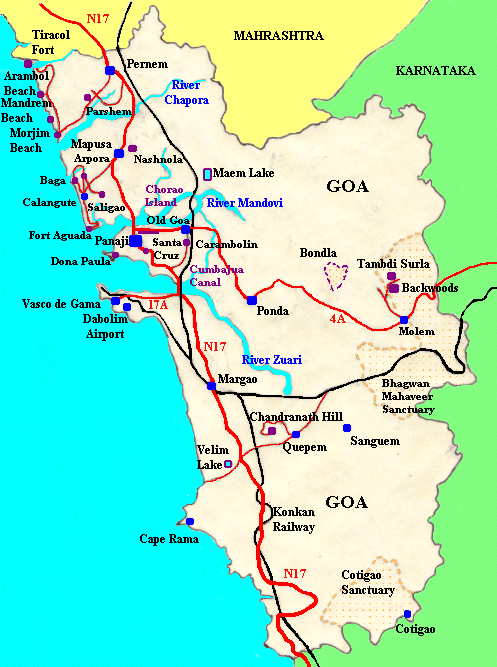
I visited Goa with Amanda between 14th and 29th February 2004. The trip was arranged with Thomas Cook, staying at the Marinha Dourada, Baga/Arpora and flying from Manchester via Bahrain with Monarch. Total cost was £1364 (£682 each) for Bed and Breakfast plus in-flight meals and transfer costs. At the time the exchange rate was 85.61 Rupees to £1.
Visas were required from the Indian High Commission at a cost of £32 each – application forms are available online (Cost £82 plus tax for British passport holders 10/14).The form asks for two referees in India. Don’t worry, just use your Tour Operator as a single referee – this is acceptable.
Research and Trip Essentials
A good bird guide such as the Pocket Guide to the Birds of the Indian Subcontinent by Grimmett, Inskip and Inskip (ISBN 0-7136-5165-2) is indispensable. The alternative is the A Field Guide to Birds of the Indian Subcontinent by Krys Kazmierczak (ISBN 1-873403-79-8). I took both books but hardly used the latter.
For comprehensive birding information on the internet visit the Fatbirder web site. This is an excellent starting point when researching a trip to Goa, or anywhere else for that matter.

Although not essential with a good local guide, I also took Goa The Independent Birders’ Guide by Peter Harris (ISBN 0-9529181-0-2) published in October 1996 and currently out of print (March 2006). This guide contains many detailed maps of all major sites, however it is now beginning to appear a bit dated, especially the Species details, with many names having subsequently changed. Some site details are also incorrect as there is no longer access to the Ciba-Geigy pools and the Merck Meat Factory Dump no longer exists. Hopefully, a new book is now being compiled and should be available in the near future.
Further background and site information can be found in A Birdwatchers’ Guide to India (Prion Birdwatchers’ Guide Series) by Krys Kazmierczak & Raj Singh (ISBN 1-871104-08-4)
Most of the sites we visited are well described in Harris’s booklet. There are also several trip reports on the internet which can be found on the Birdtours site and also CloudBirders.

A good travel guide such as the Lonely Planet Goa & Mumbai (Travel Guide) will give you an excellent flavour of what to expect and advises on everyday equipment you may need to make your stay more comfortable. We went well prepared with medical kit etc mainly from Boots, costing us c£80. In the event we had no problems whatsoever, but the antiseptic wipes were very refreshing during long hours in the field.
Also don’t forget scope and bins and digital camera, if that way inclined!
FLIGHTS
The scheduled flight times were good, departing Manchester at 4.10 pm, arriving in Goa at 9.10 am the following morning. Returning, we left Goa at 10.40 am scheduled to arrive in Manchester at 6.15 pm the same day – we were actually 30 mins early, despite leaving Goa about 40 mins late. Transfer time to the Marinha Dourada by coach is about 1 hour, but can take longer when other hotels are also involved. Flights were fairly uneventful but very cramped. Monarch flies Airbus 300 planes with three rows of three seats across the body of the jet. Leg room is at a premium and the classification “Cattle Class” springs to mind. Departing Goa is also a nightmare of bureaucracy with up to 10 checks of individuals, baggage and documentation. The subsequent stay in the Departure Lounge is not the most comfortable and spacious in the world either. De-planing at Bahrain is quite painless and gives a welcome opportunity to stretch and get mobile again. Airport security is well managed and the facilities are good.
HOTEL
The hotel appeared to be one of the best in the area and the Thomas Cook Rep said it was the best of the five she looked after including the Ronil Beach Resort. Although there was no hot water for early morning showers c 6.00 am we had no complaints for the rest of the day and only had two brief power cuts in the early evening. 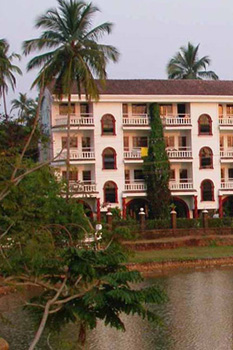 We never managed breakfast in the hotel as the service started at 7.00 am and we were always out birding by then. We lunched at the hotel on several occasions and the food was fine. The room was spacious with a fridge, air conditioning and a ceiling fan. The air conditioner stopped producing cold air approx 5 times; however repairs were prompt and efficient. The beds have very thin mattresses and are uncomfortable unless you are used to sleeping on a board. The laundry service is fast and cheap although the sheets are not “white” and have numerous “clean” stains and the towels are similar with and a strange residual odour – a remnant of the water/sewage system?
We never managed breakfast in the hotel as the service started at 7.00 am and we were always out birding by then. We lunched at the hotel on several occasions and the food was fine. The room was spacious with a fridge, air conditioning and a ceiling fan. The air conditioner stopped producing cold air approx 5 times; however repairs were prompt and efficient. The beds have very thin mattresses and are uncomfortable unless you are used to sleeping on a board. The laundry service is fast and cheap although the sheets are not “white” and have numerous “clean” stains and the towels are similar with and a strange residual odour – a remnant of the water/sewage system?
ALTERNATE ACCOMMODATION (added March 2005)
A word of warning to unwary travelers: a friend of ours, Frances Gatens, was in Goa at the same time in February 2004 and had been there on a number of occasions previously. She returned in November 2004 and writes:-
“As a fairly experienced visitor to Goa I feel that I should warn would-be visitors who may be looking for accommodation to steer clear of the Villa Fatima. In the past I have always stayed at well known hotels in the Baga/Calangute area and have found them to be less than luxurious but perfectly adequate. On my last trip (November 2004), I decided to look for alternative accommodation and found reference in various travel guides to the Villa Fatima. It was described as being ‘clean and wholesome’ or words to that effect, and it also had the added attraction of being close to the area that I knew well, i.e. Baga and Calangute. When my friends and I arrived at the hotel we were so shocked by the state of the place that we refused to stay there. It would be an understatement to say that it was filthy; for example, in the room that I had been allocated there was a colony of ants living under the menu card on a side table; obviously they had not been disturbed for some time. When I looked over the balcony of my room, there below was a substantial rubbish tip complete with rats. The whole place had the appearance of neglect. We are still trying to obtain some recompense, so far without success.”
For the time being, at least, it would appear wise to give the Villa Fatima a wide berth!
FOOD
For us avoiding Delhi belly wasn’t a problem. We were fortunate enough to have several good restaurants recommended to us by the Thomas Cook Rep and had excellent evening meals at the following restaurants on more than one occasion:-
Mooncrest (everything) and J&A’s (Italian) at Baga River (taxi 50Rs each way)
Kim Faa (Chinese) and Le Francais (French) at Baga (taxi 75Rs each way)
Midas Touch (everything) at Calangute (taxi 90Rs each way)
It was unusual to have a two course meal costing more than 800Rs for two (£10) unless accompanied by a bottle of wine which doubles the price.
Taxi drivers struggled to find the Le Francais restaurant which only opens Monday to Thursday, but it is behind a well known restaurant called Maya (Indian) which was also recommended but we didn’t have the chance to go there. There are loads of restaurants everywhere covering all sorts of price ranges and if you wish to travel a little further afield the following also came highly recommended – Little Italy, Suzie Lobos (everything), After 8 (steak etc) and Au Reverie (fine cuisine), all in Calangute, plus Milco’s (salads etc) at Candolim. Lila Café at Baga River is also highly recommended (we went 3 times) however it is only open for breakfast and lunch until late afternoon.
WEATHER
Daily temperatures increased during our stay and in the second week were regularly reaching 40°C in the early afternoons. Humidity was relatively low, but the best birding was done in the early mornings and late afternoons with welcome breaks back at the hotel where possible. In forested areas the temperatures were more bearable under the thick canopy. Locals told us that the weather was approximately one month ahead of itself.
GUIDES & BACKWOODS
Getting a good guide/taxi driver is essential and following the advice of a number of Trip Reports on the Internet we contacted Abhi Naik by e-mail early in December 2003 as soon as we had confirmed our trip and by return had his confirmation he was available to guide us throughout our stay. All we had to do was call him on his Mobile when we arrived. The doubts set in on the flight as we met Paul and Mike from Sheffield, coincidentally sitting next to us, and they said they also had hired a guide by e-mail. Surprise, surprise, it was Abhi. Contacting Abhi on our arrival on Sunday we were initially fobbed off with a promise to meet at 6.00 pm Monday to discuss our requirements. After some pushing he said he was going out with another group of four to Maem Lake at 6.00 am on Monday and we could join them if we wished. Paul and Mike were similarly advised. Abhi said he would not be available to guide us the next day as he had agreed at the last minute to guide a party introduced to him by someone from the RSPB for 3 days. He said he would contact us at 7.00 pm on Monday evening when his arrangements were clearer to confirm when he would next be available. Having waited at the hotel for the call and sent a text to his mobile, we received a call from Abhi at 6.30 pm on Tuesday to say he had been able to arrange to take us to Carambolin Lake on Wednesday. 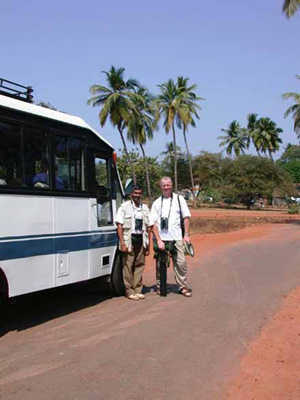 By then we had already been to Carambolin Lake and had made alternate arrangements for the next few days as we knew from talking to other birders Abhi had already made arrangements to take them out.
By then we had already been to Carambolin Lake and had made alternate arrangements for the next few days as we knew from talking to other birders Abhi had already made arrangements to take them out.
Although Abhi may be an excellent birder, his interpersonal skills and apparent greed in not turning groups away when he is already committed, leave a lot to be desired and his unreliability means I am unable to recommend him.
The saviour of our trip was Lloyd Fernandes who Paul and Mike bumped into at the Biera Mar on their first two nights. They arranged to go to Carambolin Lake with him on Tuesday and at 6.30 am we turned up at the hotel gate on spec with all our gear in the hope we could join them. The rest as they say is history. Apart from the trips on the Zuari River and our three days at Backwoods we used Lloyd every day and had a wonderful time, clocking up 248 species and 148 lifers for me (reduced by a possible further 26 from a business trip to Bangladesh three years earlier).
Lloyd operates under the name Birds & Breakfast and has been birding for 6 years. He runs a small coach seating c18 but 10 (European size) much more comfortably. Breakfasts are simple but very welcome, consisting fresh rolls, hard boiled eggs, cheese, jam, honey, plus tea and coffee. On the long day to Bondla lunch was also provided. Lloyd’s birding skills are excellent, he is immensely patient and a gentleman and I can wholeheartedly recommend his services to either individuals or groups.
Five days after our arrival we were joined by our friends Pat & Judy Hayes from Stratford-upon-Avon, just in time for our first boat trip on the Zuari River and we birded with them, amongst others, for the remainder of our stay.
 Backwoods is a camp in the forest of the Western Ghats close to Molem – the Bhagwan Mahaveer Sanctuary. The camp is fairly basic, with six sheds and six tents plus open air shower and flush toilet at the rear of each tent. Pet tree frogs are sometimes a non-optional extra along with spiders and other creepy-crawlies. Having said this we had no problems with the wildlife apart from the occasional mosquito. Each tent/shed has two unforgiving beds plus a table and a fan. A mirror would have gained another star. Despite warnings that nights were cold, we were hot and kept the fan going all night.
Backwoods is a camp in the forest of the Western Ghats close to Molem – the Bhagwan Mahaveer Sanctuary. The camp is fairly basic, with six sheds and six tents plus open air shower and flush toilet at the rear of each tent. Pet tree frogs are sometimes a non-optional extra along with spiders and other creepy-crawlies. Having said this we had no problems with the wildlife apart from the occasional mosquito. Each tent/shed has two unforgiving beds plus a table and a fan. A mirror would have gained another star. Despite warnings that nights were cold, we were hot and kept the fan going all night.
Food is basic Goan cuisine and only lightly spiced. I don’t like curry but never refused anything we were served up. We were led by Pramod and Loven who are both excellent birders. The general camp routine involves tea and biscuits at dawn (6.30-7.00 am) followed by a walk in the forest, returning to camp for breakfast at around 10.30 am. After breakfast a second walk follows, until 1.00 pm when lunch is served. There is then a rest period until c 3.00 pm when tea and biscuits is followed by the third walk of the day which usually ends at dusk, looking for nightjars. All walks are around the camp and surrounding area plus the Tambdi Surla temple nearby. A stay at Backwoods can be organized by email (see Contacts). Up-to-date prices and further information can be found on their web site.
We went on two trips on the Zuari River with Pramod, taking two different but similar routes, and enjoyed each immensely.
Our two nights at Backwoods cost 4000 Rupees each (8000Rs – c £100 in total) and the boat trips were 750 Rupees each (2 x 1500Rs c £37.50 in total). Our various trips with Lloyd (7 in total) cost 4350 Rupees each (8700Rs – c £108.75 in total). Not the most expensive birding ever but certainly the most enjoyable to date.
Itinerary
Day 1. Arrival, Hotel area pm.
Bird List – Arpora/Marinha Dourada | Bird List – Arpora Wood
Marinha Dourada
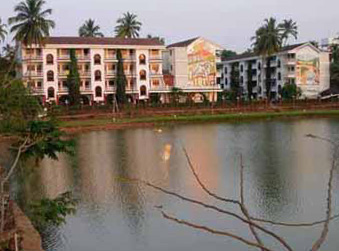
The Marinha Dourada proved to be an excellent base from which to bird the main areas in north and central Goa. Two small man-made lakes can be seen from the hotel balconies. Although not very productive in themselves, hirundines, swifts and various raptors frequently fly over. The nearby saltpans are good for waders and pipits, but the locals were rebuilding the banks of the individual pans during most of our stay, reducing bird numbers accordingly. Baga River is nearby and the whole area produced 51 species with numerous short visits when time permitted.
Arpora Wood
Arpora Wood has much better potential than Baga Hill in my view. Even though we only paid two brief visits we saw 35 species, but missed out on the local Indian Pitta. With hindsight we should probably have spent more time here as friends Pat & Judy, who were with us for 9 days, visited the site twice after we left, spending more time and seeing more species. Arpora Wood can be found by turning right out of the Marinha Dourada gate and walking along the road to the T-junction. Turning left, the road reaches a sharp left-hand bend after about ¾ mile with a surfaced track leading to the Cabana Nightclub on the right. Walking down the track past the club there is an opening on the right leading to more open ground and with tracks skirting the base of the wooded hillside. Our friends had good results here. The Indian Pitta had been seen around the shaded area just past the nightclub in the scrub to the right of the path, up to the opening on the right. We followed the main track taking the left hand fork past a small quarry and continuing up the left hand side of the valley in fairly thick scrub and woodland. A taxi provides a speedier & cooler trip to Arpora Wood at 50Rs each way, leaving more time for birding.
Day 2. Maem Lake and Nachinola Fields am and Hotel area pm.
Maem Lake| Bird List

We visited Maem Lake on our only trip with Abhi, leaving the Marinha Dourada at 6.15 am to get to the lake a little after first light. The journey takes up to 1½ hours. The Brown Fish Owl for which this site is well known now appears to roost elsewhere. The main purpose of our visit was to see an Oriental Dwarf Kingfisher Abhi had seen the previous day, but we were unlucky. We did however get excellent views of a roosting Indian Jungle (Grey) Nightjar plus Banded Bay Cuckoo, a nesting Pied (Bar-winged) Flycatcher-shrike, Little Spiderhunter, Blue-faced Malkoha, Emerald Dove, a small flock of Orange-breasted Green Pigeons, Tickell’s Thrush and Changeable Hawk-eagle. 59 species in total, boosted to 68 for the overall trip by a brief stop at Nachinola Fields on the way back to the hotel.
Nachinola Fields | Bird List
We visited this site briefly at c12.00 noon in scorching heat. Abhi parked by a narrow causeway between dried out fields with drainage ditches branching off into the fields. We saw 12 species in all with very distant views of c30 Yellow-wattled Lapwing in the long dry grass, an over-flying Asian Openbill and the only Pintail Snipe of the trip, flushed from the main ditch along the roadside.
Day 3. Carambolin Lake | Bird List
Situated a few kilometres south-east of Old Goa, the lake is approximately 50 minutes from Baga. We visited Carambolin twice as it is an excellent area for waterbirds in particular. Our first visit was also our first day out with Lloyd. He picked us up at the Marinha Dourada at 6.30 am and by 7.30 am we were birding from the spot marked (A) on the map. At 9.00 am we moved to the more shaded spot marked (B) for breakfast and more birds, with several new species picked up in the scrub and wooded area behind (B).
As the day heated up numerous raptors circled overhead. Villagers were thinning out the vast expanses of weed and water lilies at the shallower end of the lake on both our visits and whilst there were still plenty waterbirds, apart from Garganey, European ducks were absent and we missed both Spot-billed Duck and a single Comb Duck that was seen both just before and just after our second visit.
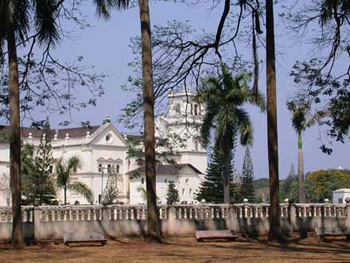 After spending several hours round the lake we returned to Old Goa for a spot of lunch, some shade and a walk around the cathedral where the remains of Saint Francis Xavier are interred. He was a Spanish missionary known as the Apostle of the Indies and he was also a founding member of the Jesuit Society.
After spending several hours round the lake we returned to Old Goa for a spot of lunch, some shade and a walk around the cathedral where the remains of Saint Francis Xavier are interred. He was a Spanish missionary known as the Apostle of the Indies and he was also a founding member of the Jesuit Society.
After our rest, we headed to the area marked (D) and (E) on the map, overlooking mud flats on one side of the road with fields and a small river opposite. On our return we visited Carambolin Wood (C) to find the roosting Brown Hawk Owls. One of the older villagers follows birdwatchers around the wood and will show you the roost site in the hope of receiving a few Rupees – 20Rs seems to be acceptable as the first offer of 10Rs was ignored.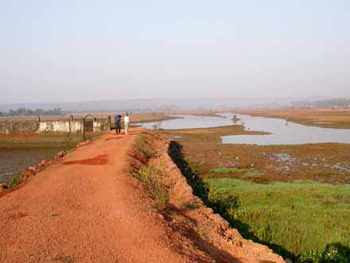
On our second visit we reversed the route and tried the mud flats first, hoping to see Small Pratincole. We seemed to miss what few of these birds were around at virtually every site and this was no exception.
A very close group of six Temmink’s Stint almost made up for our disappointment.
During the two visits the Carambolin area yielded 107 species, to closely rival Backwoods for the most productive outings. With more time and further visits I’m sure the area would produce even more species.

Day 4. Bondla | Bird List
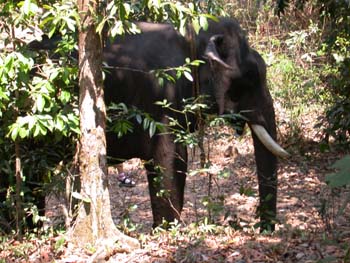
Bondla is the smallest of Goa’s three national reserves all situated in the Western Ghat mountains, with only 8 square km of forest and a small, rather down-at-heel zoo at its centre. It is about a 2 hour drive from Baga and our full day trip started at 6.00 am. With Lloyd providing both breakfast and lunch. We made several stops along the 6km approach road at Lloyd’s favoured spots, including the small reservoir, where with dusk approaching we saw our only Forest Wagtails and Grey Junglefowl. A number of species we saw were only repeated at Backwoods/Tambdi Surla and the visit also saw our only Red-breasted Flycatcher and Crested Treeswifts of the trip. An excellent but hot day’s birding produced 66 species. In addition we also saw plenty of Langur Monkeys, Spotted Deer, Samba and Wild Boars. Bondla also has the only public loo we saw in Goa where relief can gained for 1 Rupee!
Day 5. Morjim Beach am, Saligoa Zor and Arpora Wood late pm
Morjim Beach | Bird List
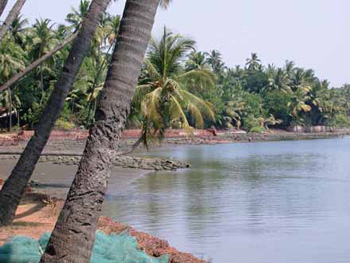 The bridge over the Chapora River makes this journey about 40 minutes from Arpora. We visited Morjim twice, once as high tide approached and later about 2 hours after high tide. Before breakfast under the shade of palm trees on our first visit we watched a mixed flock of 200/300 plovers, mainly Lesser Sand Plover and Kentish Plover but with a respectable number of Greater Sand Plover. Amongst the flock we were also lucky enough to find a wintering Caspian Plover. Gulls were numerous on both visits with c150 Pallas’s Gull making a tremendous spectacle. A few terns were present on both visits with Great Crested being difficult to pick out among the more numerous Lesser Crested. Across the road from the beach is an area of scrub with a Black-crowned Night Heron roost in the large tree at its centre.
The bridge over the Chapora River makes this journey about 40 minutes from Arpora. We visited Morjim twice, once as high tide approached and later about 2 hours after high tide. Before breakfast under the shade of palm trees on our first visit we watched a mixed flock of 200/300 plovers, mainly Lesser Sand Plover and Kentish Plover but with a respectable number of Greater Sand Plover. Amongst the flock we were also lucky enough to find a wintering Caspian Plover. Gulls were numerous on both visits with c150 Pallas’s Gull making a tremendous spectacle. A few terns were present on both visits with Great Crested being difficult to pick out among the more numerous Lesser Crested. Across the road from the beach is an area of scrub with a Black-crowned Night Heron roost in the large tree at its centre. 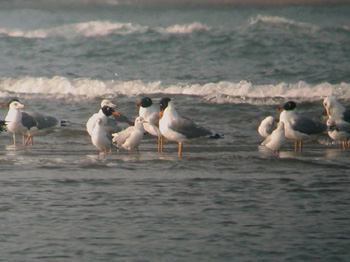 Lloyd also showed us two Spotted Owlet roosting nearby. On our second visit, whilst having breakfast Pat spotted a large warbler working the trees at the roadside for insects. He had found our only Clamorous Warbler of the trip. The second visit also yielded our first Brahminy Starling, Grey-breasted Prinia and Black-shouldered Kite to give a total of 58 species for the two visits.
Lloyd also showed us two Spotted Owlet roosting nearby. On our second visit, whilst having breakfast Pat spotted a large warbler working the trees at the roadside for insects. He had found our only Clamorous Warbler of the trip. The second visit also yielded our first Brahminy Starling, Grey-breasted Prinia and Black-shouldered Kite to give a total of 58 species for the two visits.
Saligoa Zor | Bird List

We visited the site twice to see the Brown Wood Owls as Pat and Judy had not arrived in Goa when we first went. Lloyd knew exactly where to find the owls around the back of the Zor and up a narrow path on the hillside. On our first visit we also had excellent views of a Besra perched a few feet above us on a vine stretching between two large trees, and a White-browed Fantail a few feet away as we crossed the stream bed. A white male Asian Paradise Flycatcher and a female also performed well for us here and the area is quite good for Raptors overhead. 38 species in total represented a good haul for such a small site.
Day 6. Baga Hill am and boat trip on Zuari River pm.
Baga Hill | Baga Hill Bird List
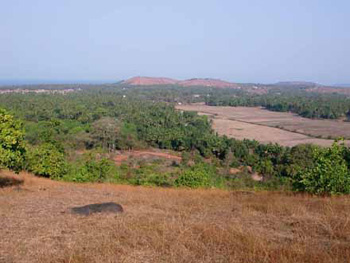
Direction from the Marinha Dourada and access are well described in the report on Paul’s Birding Site. Our single early morning walk here was disappointing, yielding only 17 species. Perhaps we were unlucky. However we did have outstanding views of a Shikra perched in the open, right above our heads. The subsequent breakfast at Lila Café quickly refreshed our flagging spirits.
Baga Fields | Baga Fields Bird List
The area was quite dry when we visited once in late afternoon. We walked from the Biera Mar Hotel towards the concrete bridge over the Baga River. The main target was Greater Painted Snipe which seemed to have re-located from the Biera Mar to a small pool near the bridge. Two females duly obliged as we arrived and stayed motionless for up to 30 minutes as we surveyed the surrounding area. We saw 37 species in 2 hours here and missed out on Zitting Cisticola and Short-toed Lark which we knew were around from talking to other birders.
Zuari River | Bird List
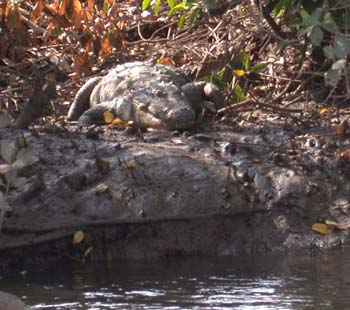 We arranged the trips with Pramod at Backwoods by e-mail before leaving the UK. Amanda likes boat trips; hence the two journeys. However, it is a good way to spend the hot afternoon, in the shade with a breeze on the river. With a week between trips, we were picked up at the Marinha Dourada at 2.30 pm on both days and enjoyed both high and low tide. The first trip started and returned to Agassaimo, near the mouth of the Zuari and with exposed mud banks nearby we were soon watching waders, including several Terek Sandpiper. We had good views of at least 3 Collared Kingfisher and ended the day with all six of the more common kingfishers.
We arranged the trips with Pramod at Backwoods by e-mail before leaving the UK. Amanda likes boat trips; hence the two journeys. However, it is a good way to spend the hot afternoon, in the shade with a breeze on the river. With a week between trips, we were picked up at the Marinha Dourada at 2.30 pm on both days and enjoyed both high and low tide. The first trip started and returned to Agassaimo, near the mouth of the Zuari and with exposed mud banks nearby we were soon watching waders, including several Terek Sandpiper. We had good views of at least 3 Collared Kingfisher and ended the day with all six of the more common kingfishers.
The second trip, at high tide, started much further up the Cumbajua Canal, east of Old Goa. This time we had at least 5 Collared Kingfisher with one particular pair giving excellent and prolonged views. We saw a single Marsh Mugger Crocodile on this trip and had close views of 12 roosting Black-headed Ibis, Oriental Darter and numerous egrets and herons. We returned to Agassaimo were we had excellent views of Great Crested Tern and a smaller number of Lesser Crested Tern on wooden piles driven into the river bottom and apparently used by the local fishermen. We saw 43 species on the two trips and thoroughly enjoyed being out on the river.
Day 7. Velim Lake am, Dona Paula and Santa Cruz early pm.
Velim Lake | Bird List
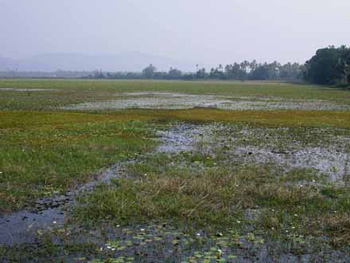
The drive to Velim Lake is about 1½ hours from Baga and Lloyd picked us up at 6.00 am. We initially stopped on the western edge of the lake with rice paddies on the opposite side of the road. Although our main target was vultures, we saw a total of 60 species in the area including all the usual waterbirds. In India the vulture population has been decimated during the last few years with the major cause now identified as diclofenac, a drug used in the treatment of livestock.
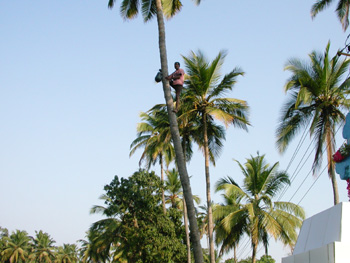 Velim is now the only reliable roosting site in Goa with just a handful of birds. As the morning heated up we had breakfast and then moved on to the opposite side of the lake where we had seen numerous raptors circling in the thermals.
Velim is now the only reliable roosting site in Goa with just a handful of birds. As the morning heated up we had breakfast and then moved on to the opposite side of the lake where we had seen numerous raptors circling in the thermals.
Having taken a small road at the eastern end of the lake we walked out across dry fields trying to find any shelter from the sweltering heat. We saw 3 Yellow-wattled Lapwing, our only Hoopoe of the trip and I found a lifer for Lloyd – a single Common Starling. As we reached wetter paddies we had to halt but still enjoyed good views of c6 White-rumped Vultures with excellent close-ups of Black Kites and a White-bellied Sea Eagle. Driving away from Velim we had excellent views of 11 Woolly-necked Storks and 7 Asian Openbills feeding in fields by the roadside.
Dona Paula | Bird List
We visited Dona Paula on the way back from Velim Lake specifically to catch up with Ashy-crowned Sparrow Lark. Almost immediately we had good views of a pair of birds moving around on the ground. Over the next 20 minutes, walking around the plateau we had excellent views of a further 10/12 males and females. Although they were mobile there appeared to be at least 6 pairs. Although we only saw 9 species we were well pleased with our stop.
Santa Cruz | Bird List
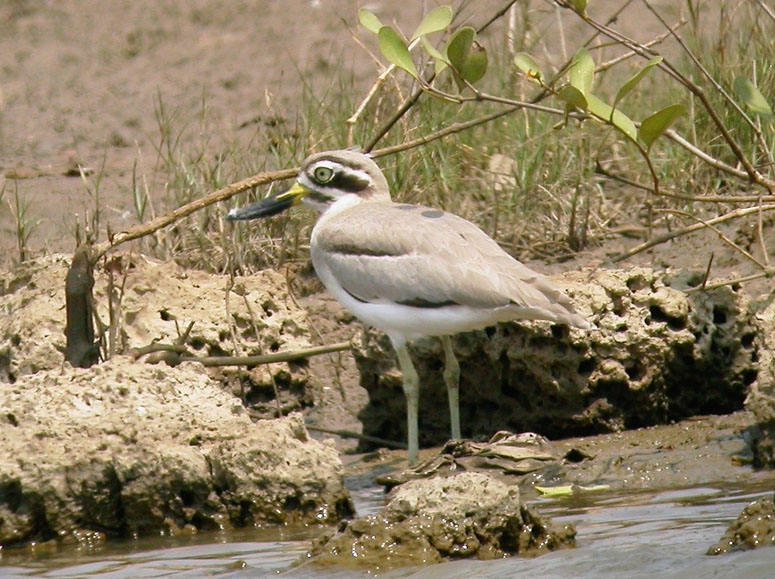
On our first river trip Pramod told us there was a Great Thick-knee at Santa Cruz. Although Lloyd hadn’t heard the news, continuing on from Dona Paula, he took us straight to a spot by the billboards, opposite the shrine on the main road where there are a number of sandy pools interspersed with scrub. We quickly scanned the roosting waders and Paul found the Thick-knee after about 5 minutes. Leaving this site we drove down the road, turned right and passed the church and school coming to a large expanse of wetlands and marsh on either side of the road. This area appeared to have potential but at 2.30 pm when we had only gone out for half a day and with most of the party visibly wilting, we decided to call it a day with only 14 species, but our main objective achieved. Much to our surprise (in addition to Amanda and I, we were with Mike and Paul and Pat and Judy) Lloyd stopped off at his house, introduced us to his wife and family and treated us to cold beers and an afternoon snack of very tasty Goan food.
Day 8. Fort Aguada, Chorao Island am, Baga Fields and Biera Mar pm.
Fort Aguada | Bird List
We made a 6.30 am start to visit the area around Fort Aguada and enjoyed some refreshing early morning birding on a hillside overlooking the bay below the Fort. We saw our only Indian Peafowl here with c6 birds roosting and feeding.
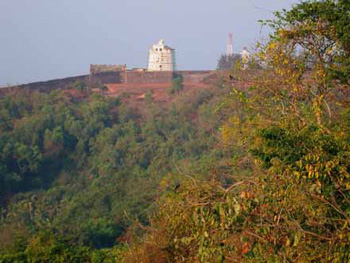
Offshore, we saw several Bottle-nosed Dolphins lazily swimming by. We had breakfast surrounded by a feeding flock of Rosy Starling and then set off downhill (all the way in some eyes) to the well known Indian Pitta site by the aptly named ditch. We missed our target yet again, perhaps because none of us wanted to venture into the undergrowth! We moved on with 38 species including close up views of a Black-headed Cuckoo-shrike in lieu of the Pitta.
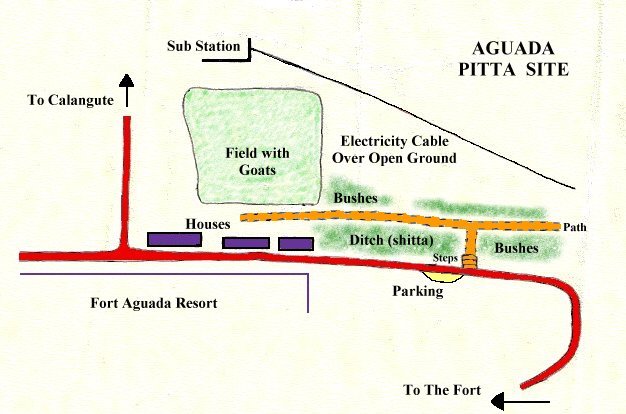
Chorao Island | Bird List

From Fort Aguada we moved on to the Ribander Ferry as foot passengers and briefly birded the area to the right of the ferry landing (or left if you are leaving rather than arriving) on the north bank of the Mandovi River. There are a few pools about 100 yards from the ferry which are good for waders at high tide. Our total of 21 species included excellent views of feeding Wooly-necked Stork and Black-headed Ibis, together with our only Eurasian Spoonbill and a mixed flock of curlew and whimbrel. In the middle of the river was a flock of 2000/3000 pintail, which took flight at one stage with a passing raptor providing a magnificent spectacle.
Biera Mar
The hotel has definitely seen better days. Despite many recommendations in other trip reports we were very disappointed with our only visit here. The area had dried out considerably other than right up against the back wall of the Hotel. There were numerous mosquitoes and with a bird list not worth recording, the birds we did not see far outnumbered those we did. There were no rails, crakes, bitterns, watercocks, or warblers of any description. We did see two large Rat Snakes, one of which caught a rather noisy frog, much to the annoyance of an Indian Pond Heron which was also stalking it. The Heron was not prepared to admit defeat lightly and dragged the snake, with the frog firmly clamped in its mouth, around the marsh for nearly 20 minutes before leaving the snake victorious with a very bloody frog still clamped firmly in its jaws. Three or four White-fronted Waterhens and a distant flock of Rosy Starlings were the only other sightings of note plus a brief glimpse of a Shikra perched on the trees below the Biera Mar wall.
Day 9. Carambolin Lake.
Day 10,11 and 12 | Bird List – Tambdi Surla | Bird List – Backwoods
Along with Paul and Pat & Judy we were picked up from the Marinha Dourada at 5.15 am for our two night/three day trip to Backwoods. The journey takes about 2½ hours and our first stop was the Mahadeva Temple at Tambdi Surla.  After a short wait for Pramod and the rest of the party to arrive from Baga, we set off towards the Temple. Almost immediately we saw Grey-fronted (Pompadour) Green Pigeon feeding in a flowering tree, closely followed by an Asian Fairy Bluebird and Malabar (Crimson-fronted) Barbet. In fairly quick succession we saw numerous forest birds, some of which we had already seen at Bondla, including Vernal Hanging Parrot, Malabar Parakeet and a distant Mountain Imperial Pigeon. We also had excellent views of a Malabar Giant Squirrel, leaping through the treetops. We then continued to Backwoods for breakfast. Following a short break we were taken by mini-bus to a grassy area interspersed with trees and partially surrounded by a range of hills for a Raptor watch. We had good views of Crested Goshawk, Crested Serpent Eagle, Mountain Hawk Eagle and Black Eagle together with Swifts and Hirundines. We returned to Backwoods for lunch and a well earned rest. Later we again went by mini-bus to an area nearby were we were later to look for nightjars. One of the first birds we saw was a soaring Long-billed Vulture, making up for missing this bird at Velim Lake.
After a short wait for Pramod and the rest of the party to arrive from Baga, we set off towards the Temple. Almost immediately we saw Grey-fronted (Pompadour) Green Pigeon feeding in a flowering tree, closely followed by an Asian Fairy Bluebird and Malabar (Crimson-fronted) Barbet. In fairly quick succession we saw numerous forest birds, some of which we had already seen at Bondla, including Vernal Hanging Parrot, Malabar Parakeet and a distant Mountain Imperial Pigeon. We also had excellent views of a Malabar Giant Squirrel, leaping through the treetops. We then continued to Backwoods for breakfast. Following a short break we were taken by mini-bus to a grassy area interspersed with trees and partially surrounded by a range of hills for a Raptor watch. We had good views of Crested Goshawk, Crested Serpent Eagle, Mountain Hawk Eagle and Black Eagle together with Swifts and Hirundines. We returned to Backwoods for lunch and a well earned rest. Later we again went by mini-bus to an area nearby were we were later to look for nightjars. One of the first birds we saw was a soaring Long-billed Vulture, making up for missing this bird at Velim Lake. 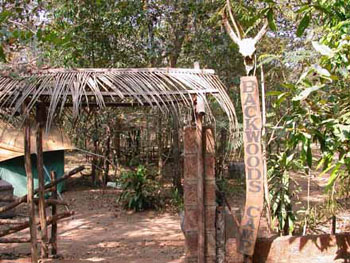 Blue-winged Leafbird, Malabar Whistling Thrush, Black-necked Monarch and Black-crested Bulbul followed as we waited for dusk and a trek up a nearby rocky hillside to wait for Nightjars. We were not disappointed as first Savannah and then Indian Jungle (Grey) Nightjars performed well in Pramod’s spotlight. We returned to Backwoods for a very welcome cold beer and our evening meal.
Blue-winged Leafbird, Malabar Whistling Thrush, Black-necked Monarch and Black-crested Bulbul followed as we waited for dusk and a trek up a nearby rocky hillside to wait for Nightjars. We were not disappointed as first Savannah and then Indian Jungle (Grey) Nightjars performed well in Pramod’s spotlight. We returned to Backwoods for a very welcome cold beer and our evening meal.
Day two started pre-dawn with an early morning wake up call from Pramod. All birders assembled near the entrance to the camp whilst Pramod played a tape of Ceylon (Sri Lanka) Frogmouth calls. The birds had allegedly been recently disturbed and moved from their usual roosting site. Very distant responses were heard and a number of disappointed birders returned to their tents to freshen up prior to tea and biscuits and a walk in the forest behind the camp with a fleeting glimpse for some of an Indian Pitta on the way. Numerous forest birds followed including Velvet-fronted Nuthatch, Black-hooded Oriole and a small flock of stunning male and female Scarlet Minivets. Amanda then excelled herself finding a roosting Jungle Owlet which we were also able to show to Loven and his small group as they joined us from the opposite direction. 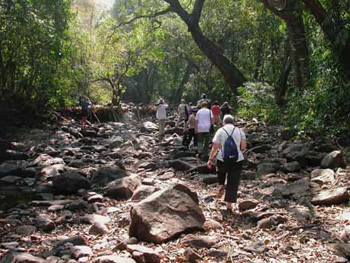 After returning to the camp for breakfast Pramod then led us off briefly into the forest at the front of the camp to the roosting site of a pair of Oriental Scop’s Owls. We also had Heart-spotted Woodpecker, Western Crowned Warbler and a single Square-tailed Black Bulbul, before heading off to Tambdi Surla again to walk up a boulder strewn river bed looking for Blue-eared Kingfisher. Walking up to the Temple I found a female Malabar Trogon which everyone was able to get, whilst Amanda contented herself watching the resplendent male, with no one taking much notice of her discovery until it was too late and the bird flew. The walk up the river bed was eventful with many stumbles on uneven and unstable boulders and the discovery, in the middle of the river of a recently deceased water buffalo, covered in flies and being attacked by crabs whilst it rotted away nicely. The kingfisher was conspicuous by its absence but some of the party had fleeting glimpses of a Brown Fish Owl as it disappeared upstream. We returned to camp for lunch and whilst relaxing in our tents afterwards we were summoned by one of the group to their cabin where they had discovered two roosting Ceylon (Sri Lanka) Frogmouth in the middle of a clump of bamboo.
After returning to the camp for breakfast Pramod then led us off briefly into the forest at the front of the camp to the roosting site of a pair of Oriental Scop’s Owls. We also had Heart-spotted Woodpecker, Western Crowned Warbler and a single Square-tailed Black Bulbul, before heading off to Tambdi Surla again to walk up a boulder strewn river bed looking for Blue-eared Kingfisher. Walking up to the Temple I found a female Malabar Trogon which everyone was able to get, whilst Amanda contented herself watching the resplendent male, with no one taking much notice of her discovery until it was too late and the bird flew. The walk up the river bed was eventful with many stumbles on uneven and unstable boulders and the discovery, in the middle of the river of a recently deceased water buffalo, covered in flies and being attacked by crabs whilst it rotted away nicely. The kingfisher was conspicuous by its absence but some of the party had fleeting glimpses of a Brown Fish Owl as it disappeared upstream. We returned to camp for lunch and whilst relaxing in our tents afterwards we were summoned by one of the group to their cabin where they had discovered two roosting Ceylon (Sri Lanka) Frogmouth in the middle of a clump of bamboo.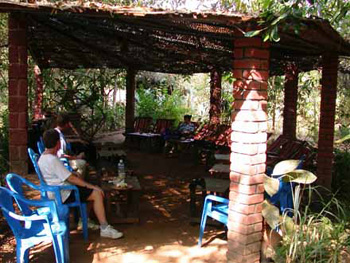 The birds were difficult to see initially but we were all able to get good views in the scopes eventually. Later Loven said they knew the birds were roosting here! Why then the early morning tape luring session? After our rest we retuned to Tambdi Surla for some relatively slow birding as we awaited dusk and more nightjar potential. We had distant views of Mountain Hawk Eagle and Rufous-bellied Eagle plus Red-throated (Taiga) Flycatcher before heading of to the grassy area to the right of the temple. Here we seemed destined to see very little with Great Hornbill conspicuous by its absence. As dusk and numerous midges arrived Pramod heard a calling Jerdon’s Nightjar and we all had excellent views of a single bird as both he and Loven switched on spotlights and briefly followed the bird around the field. Cold beer and dinner were calling strongly as we returned to the camp once again.
The birds were difficult to see initially but we were all able to get good views in the scopes eventually. Later Loven said they knew the birds were roosting here! Why then the early morning tape luring session? After our rest we retuned to Tambdi Surla for some relatively slow birding as we awaited dusk and more nightjar potential. We had distant views of Mountain Hawk Eagle and Rufous-bellied Eagle plus Red-throated (Taiga) Flycatcher before heading of to the grassy area to the right of the temple. Here we seemed destined to see very little with Great Hornbill conspicuous by its absence. As dusk and numerous midges arrived Pramod heard a calling Jerdon’s Nightjar and we all had excellent views of a single bird as both he and Loven switched on spotlights and briefly followed the bird around the field. Cold beer and dinner were calling strongly as we returned to the camp once again.
On our third and final day at Backwoods we started the day well, pre tea and biscuits, with prolonged sightings of Indian Pitta, together with Nilgiri Blackbird, Orange-headed Thrush and Indian Blue Robin at the back of the camp kitchen. We then headed for the forest to find the woodpeckers we had missed the previous day. 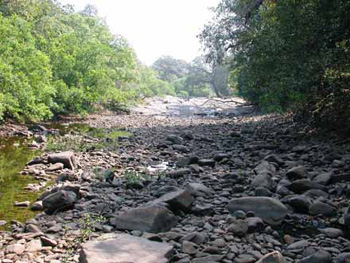 In fairly quick succession we added White-bellied, Indian (Brown-capped) Pygmy and Rufous to the Heart-spotted Woodpeckers quite common around the camp, together with Black-rumped Flameback. We also saw Large Woodshrike and a number of Common Rosefinch, including a pristine male. After breakfast we moved on by mini-bus down the road a couple of miles near one of the local “Jungle Experience” camps, to a sparsely forested area which led down to a partially dried up river with a temple nearby. We heard rather than saw Little Spiderhunter flashing by overhead, but were soon enjoying cracking views of Chestnut-headed Bee-eaters perched in the tree tops at the side of the river. Before lunch and our return to the Marinha Dourada we had final sightings of White-rumped Shama, female Malabar Trogon and a white male Asian Paradise Flycatcher to round off some spectacular birding at Backwoods. Before leaving we made one last visit to the Ceylon (Sri Lanka) Frogmouth shrine to pay our last respects.
In fairly quick succession we added White-bellied, Indian (Brown-capped) Pygmy and Rufous to the Heart-spotted Woodpeckers quite common around the camp, together with Black-rumped Flameback. We also saw Large Woodshrike and a number of Common Rosefinch, including a pristine male. After breakfast we moved on by mini-bus down the road a couple of miles near one of the local “Jungle Experience” camps, to a sparsely forested area which led down to a partially dried up river with a temple nearby. We heard rather than saw Little Spiderhunter flashing by overhead, but were soon enjoying cracking views of Chestnut-headed Bee-eaters perched in the tree tops at the side of the river. Before lunch and our return to the Marinha Dourada we had final sightings of White-rumped Shama, female Malabar Trogon and a white male Asian Paradise Flycatcher to round off some spectacular birding at Backwoods. Before leaving we made one last visit to the Ceylon (Sri Lanka) Frogmouth shrine to pay our last respects.
We saw 95 species at Backwoods and 50 at Tambdi Surla, giving a combined total of 110 species for the three days.
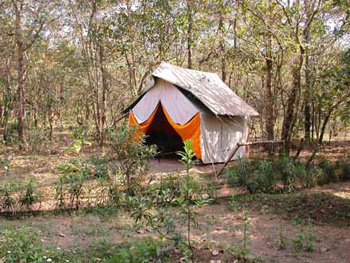 Although Backwoods was a not to be missed birding experience and added 31 new species to my Goa List, we were very glad to be returning to our air-conditioned hotel room, which by now had taken on all the appearance of luxury 5* status. Loven and Pramod are excellent birders and have a superb knowledge of songs and calls. We did however find that with a party of nine walking along a forest trail, birders behind the first 2/3 invariably missed several of the fast moving canopy dwellers being called out by the leaders. If at all possible try to get in a small group of say 4/5 for the forest walks, you will see much more.
Although Backwoods was a not to be missed birding experience and added 31 new species to my Goa List, we were very glad to be returning to our air-conditioned hotel room, which by now had taken on all the appearance of luxury 5* status. Loven and Pramod are excellent birders and have a superb knowledge of songs and calls. We did however find that with a party of nine walking along a forest trail, birders behind the first 2/3 invariably missed several of the fast moving canopy dwellers being called out by the leaders. If at all possible try to get in a small group of say 4/5 for the forest walks, you will see much more.
Day 13. Arpora Wood and Hotel area am and Boat trip on Zuari River pm.
Day 14. Morjim Beach am and Saligoa Zor pm
Day 15. Departure.
SUMMARY
Goa is an excellent birding location with very friendly people and a wide variety of restaurants providing food for all tastes at ridiculously cheap prices (by European standards). One word of caution – the people are poor and generally have no sanitation or rubbish collection facilities. It is therefore not unusual to see the roadside and beaches used as toilets. Despite all drawbacks and the lengthy flight we both enjoyed Goa and in all likelihood will return to India at any early opportunity.
Contacts
Lloyd Fernandesfatimgoa@gmail.com
Mobile (+91) 9822149002
Backwoodsbackwoodsgoa@hotmail.com (camp enquiries).
Mobile:
Loven (+91) 9822144939
Pramod (+91) 9822387434
Leio (+91) 9822139859
Backwoods also organize 2 week guided birding tours throughout India for small groups – backwoodsindia@hotmail.com (tour enquiries).
Abhi Naiknaikabi@rediffmail.com
Mobile (+91) 9822137098
HOWEVER – YOU HAVE BEEN WARNED!
Species List
Name |
Species |
Where Seen |
Little Grebe |
Tachybaptus ruficollis |
CL |
Little Cormorant |
Phalacrocorax niger |
Common |
Indian Cormorant |
Phalacrocorax fuscicollis |
CL, Z |
Oriental Darter |
Anhinga melanogaster |
CL, Z |
Little Egret |
Egretta garzetta |
Common |
Western Reef-egret |
Egretta gularis |
CL, MB, Z |
Grey Heron |
Ardea cinerea |
Common |
Purple Heron |
Ardea purpurea |
BF, CL, SC, V, Z |
Great Egret |
Ardea alba |
Common |
Intermediate Egret |
Mesophoyx intermedia |
Common |
Eastern Cattle Egret |
Bubulcus ibis coromandus |
Common |
Indian Pond-heron |
Ardeola grayii |
Common |
Little Heron |
Butorides striatus |
A, CL, ML |
Black-crowned Night-heron |
Nycticorax nycticorax |
CL, MB |
Asian Openbill |
Anastomus oscitans |
CL, NF, V |
Woolly-necked Stork |
Ciconia episcopus |
CI, CL, V |
Lesser Adjutant |
Leptoptilos javanicus |
CI, CL |
Glossy Ibis |
Plegadis falcinellus |
CL |
Black-headed Ibis |
Threskiornis melanocephalus |
CI, CL, Z |
Eurasian Spoonbill |
Platalea leucorodia |
CI |
Lesser Whistling-duck |
Dendrocygna javanica |
CI, CL, V |
Cotton Pygmy-goose |
Nettapus coromandelianus |
CL, V |
Northern Pintail |
Anas acuta |
CI |
Garganey |
Anas querquedula |
CL, V |
Oriental Honey-buzzard |
Pernis ptilorhyncus |
Common |
Black-shouldered Kite |
Elanus caeruleus |
MB |
Black Kite |
Milvus migrans |
Common |
Brahminy Kite |
Haliastur indus |
Common |
White-bellied Sea Eagle |
Haliaeetus leucogaster |
A, BH, CL, FA, MB, SC, V |
White-rumped Vulture |
Gyps bengalensis |
V, TS |
Long-billed Vulture |
Gyps indicus |
BW |
Crested Serpent-eagle |
Spilornis cheela |
BW, TS |
Eurasian Marsh Harrier |
Circus aeruginosus |
A, CL, SC, V |
Crested Goshawk |
Accipiter trivirgatus |
BW, TS |
Shikra |
Accipiter badius badius |
A, BF, BH, FA, ML, TS, V |
Besra |
Accipiter virgatus |
SZ |
Eurasian Sparrowhawk |
Accipiter nisus |
A |
Black Eagle |
Ictinaetus malayensis |
BW, TS |
Indian Spotted Eagle |
Aquila hastata |
SZ, V |
Greater Spotted Eagle |
Aquila clanga |
SZ, V, Z |
Steppe Eagle |
Aquila nipalensis |
CL, SZ |
Booted Eagle |
Hieraaetus pennatus |
AW, BH, B, CL, SZ, V |
Rufous-bellied Eagle |
Hieraaetus kienerii |
TS |
Changeable Hawk-eagle |
Spizaetus cirrhatus |
ML |
Mountain Hawk-eagle |
Spizaetus nipalensis kelaarti |
BW, TS |
Osprey |
Pandion haliaetus |
BF, CL, VL, Z |
Common Kestrel |
Falco tinnunculus |
A, BF |
Peregrine Falcon |
Falco peregrinus |
CL, Z |
Jungle Bush-quail |
Perdicula asiatica |
CL |
Grey Junglefowl |
Gallus sonneratii |
B |
Indian Peafowl |
Pavo cristatus |
FA |
Barred Buttonquail |
Turnix suscitator |
AW, CL |
White-breasted Waterhen |
Amaurornis phoenicurus |
B, BF, V, Z |
Grey-headed (Purple) Swamphen |
Porphyrio porphyrio |
CL, V |
Common Moorhen |
Gallinula chloropus |
V |
Common Coot |
Fulica atra |
CL, V |
Pheasant-tailed Jacana |
Hydrophasianus chirurgus |
CL |
Bronze-winged Jacana |
Metopidius indicus |
CL, V |
Greater Painted-snipe |
Rostratula benghalensis |
BF |
Black-winged Stilt |
Himantopus himantopus |
CI, CL, SC |
Great Thick-knee |
Burhinus recurvirostris |
SC |
Pacific Golden Plover |
Pluvialis fulva |
A, CI, SC |
Grey Plover |
Pluvialis squatarola |
Z |
Ringed Plover |
Charadrius hiaticula |
CL |
Little Ringed Plover |
Charadrius dubius |
A, BF, CL |
Kentish Plover |
Charadrius alexandrinus |
A, CL, MB |
Lesser Sand Plover |
Charadrius mongolus |
MB, Z |
Greater Sand Plover |
Charadrius leschenaultii |
MB |
Caspian Plover |
Charadrius asiaticus |
MB |
Yellow-wattled Lapwing |
Vanellus malabaricus |
NF, V |
Red-wattled Lapwing |
Vanellus indicus |
Common |
Pintail Snipe |
Gallinago stenura |
NF |
Common Snipe |
Gallinago gallinago |
CL, V |
Black-tailed Godwit |
Limosa limosa |
Z |
Bar-tailed Godwit |
Limosa lapponica |
CL |
Whimbrel |
Numenius phaeopus |
CI |
Eurasian Curlew |
Numenius arquata |
CI, Z |
Common Redshank |
Tringa totanus |
A, CI, CL, MB, SC, Z |
Marsh Sandpiper |
Tringa stagnatilis |
A |
Common Greenshank |
Tringa nebularia |
A, CI, CL, MB, SC, Z |
Green Sandpiper |
Tringa ochropus |
B, V |
Wood Sandpiper |
Tringa glareola |
A, CL, V |
Terek Sandpiper |
Xenus cinereus |
Z |
Common Sandpiper |
Actitis hypoleucos |
Common |
Ruddy Turnstone |
Arenaria interpres |
MB |
Sanderling |
Calidris alba |
SC |
Little Stint |
Calidris minuta |
A, CL |
Temminck’s Stint |
Calidris temminckii |
CL |
Steppe Gull |
Larus barabensis |
MB |
Heuglin’s Gull |
Larus heuglini |
MB |
Pallas’s Gull |
Larus ichthyaetus |
MB |
Brown-headed Gull |
Larus brunnicephalus |
CI, MB, SC, Z |
Black-headed Gull |
Larus ridibundus |
MB |
Slender-billed Gull |
Larus genei |
MB |
Gull-billed Tern |
Sterna nilotica |
CI, CL, MB, SC, Z |
Lesser Crested Tern |
Thalasseus bengalensis |
MB, Z |
Great Crested Tern |
Thalasseus bergii |
MB, Z |
Sandwich Tern |
Thalasseus sandvicensis |
MB |
Little Tern |
Sterna albifrons |
Z |
Whiskered Tern |
Chlidonias hybridus |
CL |
Rock Dove |
Columba livia |
BW, CL, NF |
Spotted Dove |
Streptopelia chinensis |
Common |
Emerald Dove |
Chalcophaps indica |
ML |
Orange-breasted Green-pigeon |
Treron bicincta |
ML |
Grey-fronted (Pompadour) Green Pigeon |
Treron pompadora affinis |
BW, FA, TS |
Mountain Imperial-pigeon |
Ducula badia |
TS |
Vernal Hanging-parrot |
Loriculus vernalis |
B, BW, TS |
Rose-ringed Parakeet |
Psittacula krameri |
A, DP |
Plum-headed Parakeet |
Psittacula cyanocephala |
AW, BW, CL, FA, MB, ML, |
Malabar Parakeet |
Psittacula columboides |
BW, TS |
Banded Bay Cuckoo |
Cacomantis sonneratii |
ML, TS |
Asian Koel |
Eudynamys scolopacea |
Common |
Blue-faced Malkoha |
Phaenicophaeus viridirostris |
ML |
Southern (Greater) Coucal |
Centropus sinensis parroti |
B, BF, BW, CL, MB, V |
Oriental Scops-owl |
Otus sunia |
BW |
Brown Fish-owl |
Ketupa zeylonensis |
TS |
Brown Wood-owl |
Strix leptogrammica |
SZ |
Jungle Owlet |
Glaucidium radiatum |
BW, CL |
Spotted Owlet |
Athene brama |
BF, MB |
Brown Hawk-owl |
Ninox scutulata |
CL |
Ceylon (Sri Lanka) Frogmouth |
Batrachostomus moniliger |
BW |
Indian Jungle (Grey) Nightjar |
Caprimulgus indicus |
ML, BW |
Jerdon’s Nightjar |
Caprimulgus atripennis |
TS |
Savannah Nightjar |
Caprimulgus affinis |
BW |
Crested Treeswift |
Hemiprocne coronata |
B |
Indian White-rumped Spinetail |
Zoonavena sylvatica |
B, ML, TS |
Brown-throated (backed) Needletail |
Hirundapus giganteus |
TS |
Asian Palm-swift |
Cypsiurus balasiensis |
A, B, BF, NF, V |
House Swift |
Apus affinis |
AW, B, BF, BH, BW |
Malabar Trogon |
Harpactes fasciatus |
BW, TS |
Common Kingfisher |
Alcedo atthis |
Common |
Stork-billed Kingfisher |
Pelargopsis capensis |
A, ML, TS, V, Z |
White-throated Kingfisher |
Halcyon smyrnensis |
Common |
Black-capped Kingfisher |
Halcyon pileata |
A, BF, MB, Z |
Collared Kingfisher |
Todirhamphus chloris |
Z |
Pied Kingfisher |
Ceryle rudis |
A, CL, ML, V |
Little Green Bee-eater |
Merops orientalis |
Common |
Blue-tailed Bee-eater |
Merops philippinus |
BF, CL, ML, V |
Chestnut-headed Bee-eater |
Merops leschenaulti |
BW |
Indian Roller |
Coracias benghalensis |
BF, MB, SZ, V |
Eurasian Hoopoe |
Upupa epops |
V |
Malabar Grey Hornbill |
Ocyceros griseus |
B, BW |
Malabar Pied-hornbill |
Anthracoceros coronatus |
B, TS |
White-cheeked Barbet |
Megalaima viridis |
B, BF, BW, CL, FA, ML, SZ |
Malabar (Crimson-fronted) Barbet |
Megalaima rubricapilla malabarica |
BW, TS |
Coppersmith Barbet |
Megalaima haemacephala |
AW, CL, FA, ML, SZ |
Indian (Brown-capped) Pygmy Woodpecker |
Dendrocopos nanus |
BW |
Rufous Woodpecker |
Celeus brachyurus |
AW, B, BW |
White-bellied Woodpecker |
Dryocopus javensis |
BW |
Black-rumped Flameback |
Dinopium benghalense |
BW, CL, SZ, V |
Greater Flameback |
Chrysocolaptes lucidus |
BW |
Heart-spotted Woodpecker |
Hemicircus canente |
B, BW |
Indian Pitta |
Pitta brachyura |
BW |
Ashy-crowned Sparrow-lark |
Eremopterix grisea |
DP |
Malabar Lark |
Galerida malabarica |
CL, MB, NF, SC |
Oriental Skylark |
Alauda gulgula |
DP |
Eurasian Crag-martin |
Hirundo rupestris |
CL, V |
Dusky Crag-martin |
Hirundo concolor |
CL |
Eurasian Swallow |
Hirundo rustica |
A, CL, FA, MB, NF |
Wire-tailed Swallow |
Hirundo smithii |
A, BW, CL, MB, V, Z |
Red-rumped Swallow |
Hirundo daurica rufula |
Common |
Streak-throated Swallow |
Hirundo fluvicola |
A, BW, CL |
Richard’s Pipit |
Anthus richardi |
MB, V |
Paddyfield Pipit |
Anthus rufulus |
A, BF, CL, MB, V |
Tawny Pipit |
Anthus campestris |
A, BF, CL, V |
Forest Wagtail |
Dendronanthus indicus |
B |
White-browed Wagtail |
Motacilla madaraspatensis |
A, BF, CL |
Yellow Wagtail |
Motacilla flava |
CL, V |
Grey Wagtail |
Motacilla cinerea |
B, BW, CL, SZ, TS |
Black-headed Cuckooshrike |
Coracina melanoptera |
B, FA |
Small Minivet |
Pericrocotus cinnamomeus |
AW, B, BW, FA |
Scarlet Minivet |
Pericrocotus flammeus |
BW, TS |
Pied (Bar-winged) Flycatcher-shrike |
Hemipus picatus |
ML, TS |
Black-crested Bulbul |
Pycnonotus melanicterus |
B, BW, TS |
Red-whiskered Bulbul |
Pycnonotus jocosus |
Common |
Red-vented Bulbul |
Pycnonotus cafer |
AW, BW, CL, ML |
White-browed Bulbul |
Pycnonotus luteolus |
AW, DP, FA |
Yellow-browed Bulbul |
Iole indica |
B, BW, TS |
Square-tailed Black Bulbul |
Hypsipetes ganeesa |
BW |
Common Iora |
Aegithina tiphia |
AW, B, BH, BW, MB, SZ |
Asian Fairy-bluebird |
Irena puella |
TS |
Blue-winged Leafbird |
Chloropsis cochinchinensis |
BW |
Golden-fronted Leafbird |
Chloropsis aurifrons |
AW, B, BW, ML, TS |
Indian Blue Robin |
Luscinia brunnea |
BW |
Oriental Magpie-robin |
Copsychus saularis |
Common |
White-rumped Shama |
Copsychus malabaricus |
B, BW |
Siberian Stonechat |
Saxicola maurus indicus |
BF, CL, NF, V |
Pied Bushchat |
Saxicola caprata |
A, CL, MB |
Indian Black Robin |
Saxicoloides fulicata |
Common |
Malabar Whistling-thrush |
Myiophonus horsfieldii |
BW, ML |
Orange-headed Thrush |
Zoothera citrina |
AW, B, BW |
Tickell’s Thrush |
Turdus unicolor |
ML |
Nilgiri Blackbird |
Turdus simillimus simillimus |
BW, ML |
Grey-breasted Prinia |
Prinia hodgsonii |
MB |
Ashy Prinia |
Prinia socialis |
CL, FA, ML, V |
Plain Prinia |
Prinia inornata |
AW, CL, FA |
Blyth ‘s Reed-warbler |
Acrocephalus dumetorum |
B, BW, CL, FA, ML, SZ |
Clamorous Reed-warbler |
Acrocephalus stentoreus |
MB |
Common Tailorbird |
Orthotomus sutorius |
AW, B, CL, FA, MB |
Greenish Warbler |
Phylloscopus trochiloides |
Common |
Western Crowned-warbler |
Phylloscopus occipitalis |
BW |
Asian Brown Flycatcher |
Muscicapa dauurica |
BW, CL, MB |
Brown-breasted Flycatcher |
Muscicapa muttui |
BW, TS, SZ |
Red-breasted Flycatcher |
Ficedula parva |
B |
Red-throated (Taiga) Flycatcher |
Ficedula albicilla |
BW, TS |
Tickell’s Blue-flycatcher |
Cyornis tickelliae |
AW, B, BW, SZ |
White-browed Fantail |
Rhipidura aureola |
FA, SZ |
Black-naped Monarch |
Hypothymis azurea |
B, BW, SZ, TS |
Asian Paradise-flycatcher |
Terpsiphone paradisi |
B, BW, FA, ML, SZ, TS |
Puff-throated Babbler |
Pellorneum ruficeps |
AW, BW, ML, SZ |
Dark-fronted Babbler |
Rhopocichla atriceps |
B, BW |
Jungle Babbler |
Turdoides striatus |
AW, B, BW, FA, SZ |
Brown-cheeked Fulvetta |
Alcippe poioicephala |
B, BW, ML, SZ |
Black-lored Tit |
Parus xanthogenys |
AW, CL, MB, ML |
Velvet-fronted Nuthatch |
Sitta frontalis |
B, BW |
Purple-rumped Sunbird |
Nectarinia zeylonica |
Common |
Crimson-backed Sunbird |
Nectarinia minima |
B, BH, BW, SZ, TS |
Purple Sunbird |
Nectarinia asiatica |
AW, B, BH, BW |
Loten’s Sunbird |
Nectarinia lotenia |
B, TS |
Crimson Sunbird |
Aethopyga siparaja |
BH, FA, ML, SZ |
Little Spiderhunter |
Arachnothera longirostra |
B, ML |
Thick-billed Flowerpecker |
Dicaeum agile |
B, BW, FA, TS |
Pale-billed Flowerpecker |
Dicaeum erythrorhynchos |
CL, FA |
Nilgiri (Plain) Flowerpecker |
Dicaeum concolor concolor |
B, BW, SZ, TS |
Indian Golden Oriole |
Oriolus oriolus kundoo |
Common |
Black-hooded Oriole |
Oriolus xanthornus |
B, BW, CL, ML |
Large Woodshrike |
Tephrodornis gularis |
BW |
Long-tailed Shrike |
Lanius schach |
Common |
Black Drongo |
Dicrurus macrocercus |
Common |
Ashy Drongo |
Dicrurus leucophaeus |
Common |
White-bellied Drongo |
Dicrurus caerulescens |
AW, B, ML |
Bronzed Drongo |
Dicrurus aeneus |
B, BW, ML |
Greater Racket-tailed Drongo |
Dicrurus paradiseus |
B, BW, SZ, TS |
Rufous Treepie |
Dendrocitta vagabunda |
B, BF, ML, SZ |
House Crow |
Corvus splendens |
Common |
Indian Jungle (Large-billed) Crow |
Corvus macrorhynchos culminatus |
B, BW, CL, TS |
Ashy Woodswallow |
Artamus fuscus |
A, BW, CL |
Grey-headed (Chestnut-tailed) Starling |
Sturnus malabaricus |
AW, B, BW, CL, SZ, V |
Brahminy Starling |
Sturnus pagodarum |
MB |
Rosy Starling |
Sturnus roseus |
A, BF, CL, FA, MB, SZ |
Common Starling |
Sturnus vulgaris |
V |
Common Myna |
Acridotheres tristis |
A, BF, MB |
Jungle Myna |
Acridotheres fuscus |
Common |
House Sparrow |
Passer domesticus |
DP |
Chestnut-shouldered Petronia |
Petronia xanthocollis |
BW, CL |
Baya Weaver |
Ploceus philippinus |
CL, FA |
White-rumped Munia |
Lonchura striata |
AW, B, BW, CL, FA, V |
Black-throated Munia |
Lonchura kelaarti |
BW |
Common Rosefinch |
Carpodacus erythrinus |
BW |
|
KEY |
Common |
All appropriate Habitats |
A |
Arpora/Marinha Dourada |
AW |
Arpora Wood |
BW |
Backwoods |
BF |
Baga Fields/ Biera Mar |
BH |
Baga Hill |
B |
Bondla |
CL |
Carambolin Lake/Woods etc |
CI |
Chorao Island |
DP |
Dona Paula |
FA |
Fort Aguada |
ML |
Maem Lake |
MB |
Morjim Beach |
NF |
Nachinola Fields |
SZ |
Saligao Zor |
SC |
Santa Cruz |
TS |
Tambdi Surla |
V |
Velim Lake |
Z |
Zuari River |
Bird Photos (Photography by David Mason and Pat Hayes)
David and Amanda Mason
